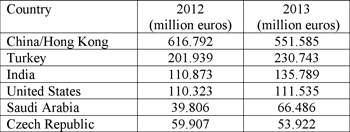Among the member associations of the European Committee of Textile Machinery Manufacturers
(CEMATEX), the German Engineering Federation (VDMA) Textile Machinery Association is by far the
biggest.
Around 120 of the most important manufacturers of textile machinery and accessories from all
sectors of the trade are affiliated within VDMA. The largest portion of the companies comprises
medium-sized companies, which represent approximately 90 percent of the entire sector volume. In
2012, the branch exported textile machinery worth about 3.1 billion euros. It seems that 2013 will
be an even better year for the German manufacturers.
Different Success Rates For Different Sectors
Exports, as everywhere in Europe, are playing a major role for the success of a textile
machinery association. VDMA is running representative offices in Brazil, China and India, to be
close to the customers in major South American and Asian markets. The offices serve as hubs between
German and Brazilian, Chinese and Indian companies and associations as well as authorities.
During a recent visit to Frankfurt, the Rupp Report had the opportunity to talk to Nicolai
Strauch, public relations officer for VDMA’s Textile Machinery Association, about facts and figures
pertaining to its members. He gave detailed information for the period of January through July
2013:
For spinning machines, compared to an export volume of 781.359 million euros in the same
period of 2012, the current period in 2013 netted 821.575 million euros. A slightly negative
development is shown with weaving machines: here, last year’s volume was 123.500 million euros, and
for 2013, it dropped to 116.721 million euros from January through July.
However, for knitting machines, VDMA reports a slight increase: compared to 452.610 million
euros in 2012, the first seven months in 2013 record a volume of 471.371 million euros. The
finishing machinery sector recorded the sharpest drop in volume: from 473.174 million euros in 2012
to 406.735 million euros in the same period in 2013.
Sharp Slowdown In China
The somewhat negative picture — which, in fact, is a positive — is mainly caused by the
declining business in China. The following interesting table shows the development of German
textile machinery exports to the most important countries over a period from January to July for
2012 and 2013:
Turkey, India, the United States and Saudi Arabia show higher export volumes, with an overall
big jump in 2013. From January through July 2013, German textile machinery and accessories worth
1.8 billion euros have been exported.
Taking a closer look at the major destinations shows that China weakened in the first half of
this year. Shipping of German textile machinery and accessories to China decreased by 11 percent
year-on-year and reached approximately 552 million Euros. The exports to Turkey, a market that
already performed very well in 2012, increased again — by 14 percent to approximately 231 million
euros.
India Is Back
But also the Indian textile industry strikes back: After two weak years, the sector invested
much more during the first half of 2013, which resulted in German deliveries worth 136 million
euros — an increase of nearly 23 percent. And a former established textile nation is celebrating a
kind of comeback: the United States. The Rupp Report has already informed its readers about the
comeback of the U.S. textile industry some months ago
(See ”
The
Rupp Report: Astonishing Investment Climate In The U.S.,”
TextileWorld.com, May 14, 2013). While the overall German textile machinery
exports to the U.S. — worth more than 111 million euros in the 2013 period — is just a small
increase, the shipping of spinning machinery nearly doubled year-on-year.
Positive Outlook
Strauch added that the latest incoming orders figures for the German textile machinery
industry increased by an encouraging 18 percent between January and August 2013 compared to the
respective period in 2012. “The high expectations of the VDMA member companies towards the export
performance indicate good business for the next months,” he said. And to end an interesting meeting
positively, he commented, “Regarding the good performance in this year, the VDMA sales forecast of
an increase of some 5 percent for 2013 proved to be realistic.” That is a promise for the future.
October 15, 2013







